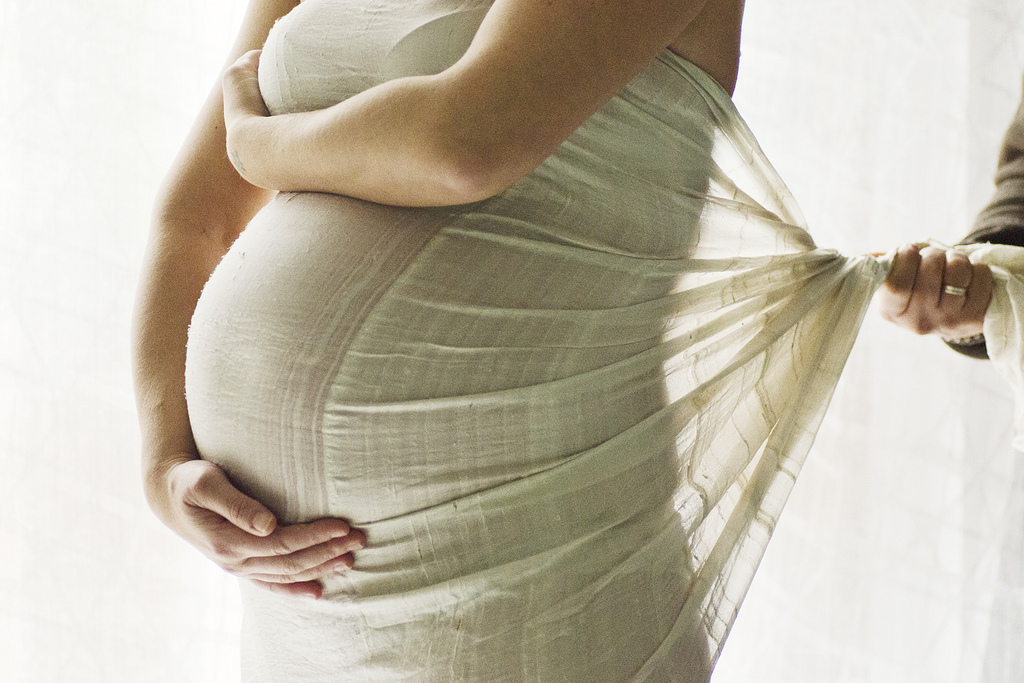Preventable Complications During Childbirth Are Skyrocketing
The rate of life-threatening problems for new mothers in the U.S. more than doubled in two decades due to pre-existing conditions, medical errors and unequal access to care. Tania Caruso / CC BY-NC-ND 2.0
Tania Caruso / CC BY-NC-ND 2.0
Leah Bahrencu’s kidneys and liver shut down.
Samantha Blackwell spent a month in a coma.
Cindel Pena suffered heart failure.
Heather Lavender lost her uterus.
Rebecca Derohanian bled into her brain.
Every year in the U.S., nearly 4 million women give birth, the vast majority without anything going amiss for themselves or their babies. But more than 135 expectant and new mothers a day — or more than 50,000 a year, according to the Centers for Disease Control and Prevention — endure dangerous and even life-threatening complications that often leave them wounded, weakened, traumatized, financially devastated, unable to bear more children or searching in vain for answers about what went wrong.
For the past year, ProPublica and NPR have been examining why the U.S. has the highest rate of maternal mortality in the industrialized world. The 700 to 900 deaths each year related to pregnancy and childbirth, though, overshadow a more pervasive problem that experts call “severe maternal morbidity.” For every U.S. woman who dies as a consequence of pregnancy or childbirth, up to 70 suffer hemorrhages, organ failure or other significant complications, amounting to more than 1 percent of all births. The annual cost to women, their families, taxpayers and the health care system runs into billions of dollars.
“There’s this misconception that these complications are rare,” said Kristen Terlizzi, cofounder of the National Accreta Foundation, who had her uterus, appendix and part of her bladder removed in 2014 because of a life-threatening placenta condition, “and we [women] get brushed off — ‘The risk is not a big deal.’ But it is.”
Better care could have prevented or alleviated many of these complications, experts say. Maternal morbidity encompasses a spectrum of problems, from moderately serious to near-deadly, and proper medical attention can stop treatable conditions from spiraling out of control. In a 2016 study of all women admitted for delivery over 30 months at Cedars-Sinai Medical Center in Los Angeles, California, researchers found “opportunity for improvement in care” in 44 percent of life-threatening complications related to pregnancy and childbirth.
What’s more, according to the CDC, severe maternal morbidity has risen faster than maternal mortality. Based on the rate per 10,000 deliveries, serious complications more than doubled from 1993 to 2014, driven largely by a five-fold rise in blood transfusions. That also includes a nearly 60 percent rise in emergency hysterectomies — removal of the uterus and sometimes other reproductive organs, often to stem massive bleeding or infection. In 2014 alone, more than 4,000 women had emergency hysterectomies, rendering them permanently unable to carry a child. The rates of new mothers requiring breathing tubes, and of treatment for sepsis — a life-threatening inflammatory response to infection that can damage tissues and organs — both increased by 75 percent. And the rate of women needing to be resuscitated from heart failure rose by 175 percent, to a total of roughly 400.
“These numbers are really high, and far too many of them are preventable,” said Dr. Elliott Main, medical director of the California Maternal Quality Care Collaborative and a national leader in efforts to reduce maternal deaths and injuries.
Judged by one of the most life-altering impacts — a hysterectomy — the U.S. is an outlier in the industrialized world. U.S. women are about five times more likely than their British and Swedish counterparts to undergo a hysterectomy, according to Elena Kuklina, a CDC health scientist. They’re also three times more likely to need a breathing tube during and immediately after childbirth than women in the United Kingdom. The U.K. has improved maternity care by requiring every doctor to follow the same treatment protocols, and by examining every death to see what mistakes may have occurred.
While hospital and government authorities in the U.S. often fail to investigate why a new mother died, complications that aren’t fatal receive even less scrutiny. More than 30 states and cities now have committees to review maternal deaths, but only one state — Illinois — has started to systematically examine severe complications. (That process, which began July 1, so far only has funding for one year.) New York City’s committee, which met for the first time this month, plans to look at both deaths and severe complications. The Joint Commission, the not-for-profit body that accredits health care facilities, requires hospitals to do a thorough analysis of severe morbidity (whether involving new mothers or any other patients) only when a complication is “not primarily related” to the “natural course of the patient’s illness or underlying condition.”
More scrutiny of near-deaths could illuminate not only what went wrong but what went right. “Maybe everything was done really, really well, and they saved the woman’s life,” said Stacie Geller, a maternal health expert who directs the Center for Research on Women and Gender at the University of Illinois at Chicago.
The U.S. government, which stopped publishing an official annual count of pregnancy-related fatalities a decade ago, has had similar difficulties tallying harm that doesn’t lead to death. After analysts fixed a computer programming error that had inflated the total, the CDC reduced its estimate of cases of “severe maternal morbidity” this year from 65,000 to more than 50,000. But its current number may be an undercount. Indeed, when one patient safety group, the Alliance for Innovation on Maternal Health (AIM), analyzed 2015 data from hospitals in four states, the rate of morbidity was roughly 2 percent of births, which would translate to 80,000 cases a year nationwide.
The CDC’s estimate encompasses 21 outcomes, from relatively minor hemorrhages if they require a blood transfusion, to kidney or respiratory failure. But it comes from hospital billing data generated when a new mother is discharged, and sometimes misses complications — bleeding, blood clots, even heart attacks — that may arise in the hours, days and weeks after she goes home. Hospital readmissions for childbirth-related ailments are difficult for researchers to track.
“The nature of our system is to focus on these women while they’re pregnant,” said Eugene Declercq, a professor of community health services at Boston University School of Public Health. “And then if there are difficulties later, they get lost to the larger system that doesn’t particularly care about women’s health to a great degree unless they’re pregnant.”
Samantha Blackwell experienced those postpartum difficulties. Eleven days after giving birth to her son in August 2014, Blackwell, then 25, woke with a pain in her lower abdomen so sharp that she couldn’t stand up straight, she said. The 25-year-old graduate student in nonprofit administration went to an emergency room at a hospital outside Cleveland, Ohio, where she was diagnosed with a massive infection and septic shock. According to her medical records, doctors performed a procedure known as a D&C, removing 400 milliliters of unidentified, foul-smelling material from her uterus. But her condition rapidly deteriorated and she was flown to a larger hospital 15 miles away.
While she lay in a medically induced coma, surgeons performed an emergency hysterectomy. When she regained consciousness a month later, she overheard her mother talking with a doctor, which was how she learned that her uterus had been removed.
“I’d have a million more kids if I could,” she said. “I hadn’t known how much I would love being a mother before they put my son on my chest.”
Blackwell was one of more than 4,000 women who shared stories with ProPublica and NPR of mothers nearly dying in childbirth. She was also one of more than 400 women who said they’d had an emergency hysterectomy. The procedure can often stop bleeding and save lives, yet it also ends women’s hopes for more children and sometimes leads to early menopause.
“Angry and sad. I woke up to find out I no longer had a uterus,” wrote 40-year-old Alicia Nichols, who works in a cosmetic surgery office in Needham, Massachusetts. After she gave birth to her first child this past March, she began experiencing bouts of bleeding, and took an ambulance to a hospital emergency room, but a doctor there told her that her symptoms were normal and sent her home, according to medical records. When her daughter was about two months old, Nichols had another scary episode, and made another appointment with an OB-GYN.
She was getting off the elevator at the doctor’s office when she began to hemorrhage. According to her medical records, she lost almost half her volume of blood. A few days after her uterus was removed, she was hospitalized with a life-threatening complication of that surgery, blood clots in both lungs.
Nichols had gotten pregnant via in vitro fertilization, freezing the extra embryos in hopes of having more children. Rather than surrender those dreams, she’s considering hiring a surrogate to carry her embryos to term — at a cost that could exceed $80,000.
Childbirth is the leading reason that people go to hospitals, accounting for nearly 12 percent of all U.S. hospital stays in 2014. Unlike the average patient, expectant mothers tend to be relatively young and healthy, brimming with joyful anticipation.
“You expect what you see in the movies,” said Leah Bahrencu, who taught Pilates and cardio-kickboxing in Austin, Texas, before she became pregnant with twins at 34. “Like it’s just routine: Your water breaks and you go to the doctor, and somewhere between four to maybe 20-something hours later, you have these babies.”
Bahrencu’s pregnancy seemed to be on track until this past January, when she was in her 34th week. At a routine checkup, she was diagnosed with HELLP syndrome, a particularly dangerous variant of preeclampsia (pregnancy-induced hypertension), and rushed to the hospital for an emergency cesarean section.
She then developed an infection that led to 10 days in a medically assisted coma. Her lungs, kidney and liver shut down, and she suffered permanent damage to her pancreas. “We almost lost her three times,” said her OB-GYN, Dr. Catherine Browne, whose voice broke repeatedly as she recalled the case.
As with many women who contacted ProPublica and NPR, Bahrencu’s problems persisted long after she finally went home. Subsequent infections sent Bahrencu to the hospital three more times, Browne said. Bahrencu stopped working outside the home and has struggled to care for her premature babies. “Emotionally, I’m a wreck,” she said. “I’m overwhelmed, and have to force myself to get out of the house. If I could, I would stay in my room while the kids are in the other room.”
She isn’t alone. Even seemingly temporary complications of pregnancy and childbirth may have long-term impacts on women’s physical and mental health. Preeclampsia, for example, substantially increases risks of heart disease and stroke later in life, while the trauma of a complicated birth can have emotional repercussions. About 1,370 women reported after-effects such as stress and depression, including more than 730 who told us that their physical suffering led to symptoms of post-traumatic stress disorder, or PTSD, a potentially disabling and sometimes chronic condition more often associated with combat veterans than with new mothers. Such symptoms can typically include flashbacks, nightmares, memory problems and feelings of hopelessness.
Up to 6 percent of new mothers suffer from PTSD, due to childbirth complications and other factors such as prior trauma, according to Sharon Dekel, an assistant professor of psychology at Harvard Medical School. Six months after giving birth, survivors of emergency hysterectomies are nearly 2.5 times more likely to have PTSD symptoms than women who didn’t have the surgery, according to a 2016 study.
“I’ve had dreams about being tied down … and feeling like I can’t breathe,” wrote a 36-year-old mother of two who teaches middle school in Manhasset, New York. She said she needed two surgeries and four pints of blood to stop a hemorrhage after an emergency C-section. “I was crying for a month after it happened,” she said.
“I feel like I can’t be without another adult with me at all times because I’m afraid of something happening to me and my baby will be alone. I constantly feel like I’m in survival mode,” wrote a 35-year-old stay-at-home mother of three in Traveler’s Rest, South Carolina, who said she survived a postpartum heart attack.
What’s behind the rise in severe morbidity in the U.S.? The reasons include striking declines in the health of women giving birth and inequities in access to insurance and maternity care.
As in most other developed countries, American mothers are older than ever. The percentage of first-time mothers over 30 rose from 24 percent in 2000 to 30 percent in 2014. The uptick in age — combined with a rise in women’s average weight — has meant that more pregnant women than ever suffer chronic ailments such as hypertension and diabetes, which make pregnancy more complex to manage and increase the risk of problems during and after childbirth. In a study of New York City hospitals from 2008 to 2012, women with significant pre-existing conditions were three times as likely as other new mothers to experience life-threatening impacts of childbirth.
Cindel Pena, 29, checked two of the boxes that increase the likelihood of a dangerous pregnancy. The 5-foot-4 project manager in Sacramento, California, weighed about 200 pounds during her pregnancy, and had previously been diagnosed with hypertension, according to Pena and her husband, Steven Peery. When her blood pressure spiked shortly before her due date in 2015, her OB-GYN ordered a C-section. The surgery went so well that Pena asked to check out of the hospital after just one day.
“That was my first mistake,” she said. Two days later, she knew something was seriously wrong. She couldn’t stop crying, she said, adding, “My husband said I was walking through the house saying ‘I’m going to die.’”
Assuming that Pena was having a panic attack, the couple drove to the nearest hospital, Sutter Medical Center, where Pena asked for medication for anxiety, she said. Instead, she was hospitalized for a week. Her OB-GYN later diagnosed her with peripartum cardiomyopathy, a type of heart failure for which hypertension and obesity are risk factors.
Pena has since recovered, and is now trying to decide whether to take the chance of having a second child. She has requested her medical records from the hospital both by phone and certified mail, without success. A hospital records staffer last week confirmed that it has not yet sent the records to Pena. A Sutter spokeswoman declined comment on Pena’s case, citing privacy concerns.
Pre-existing conditions such as asthma, hypertension, diabetes and substance use have increased disproportionately among women in rural and low-income communities, according to a study by researchers at the University of Michigan. Inadequate health insurance widens this gap. Medicaid, which pays for half of all U.S. births, covers many mothers only up to two months past delivery. As a result, for low-income women, pre-existing conditions that imperiled one delivery may go unseen and untreated until the next pregnancy.
Black women experience life-threatening pregnancy and childbirth complications at much higher rates than white or Hispanic women — in part because they have higher rates of chronic disease and prolonged stress. In Heather Lavender’s case, a different pre-existing condition —the after-effects of a prior uterine procedure — may have been a factor in her life-threatening complication.
A critical-care nurse at Johns Hopkins Hospital in Baltimore, she had a history of troubled pregnancies: several miscarriages and the birth and death of a son at 18 weeks. Her doctors removed uterine tissue that they believed was causing the problem. Her final pregnancy, in 2014, proceeded without mishap until her 39th week, when her uterus ruptured, according to her medical records. Doctors performed an emergency hysterectomy. Her son Cruz died nine days later.
“I feel like most of my life up until that point, I’m a pretty happy person, glass-half-full person,” she said recently from New Mexico, where she now works as a nurse for the Indian Health Service. “I’m not sure what I am now.”
Not only do women today enter pregnancy in more compromised health, but the medical care they receive sometimes compounds the danger. When researchers have analyzed maternal deaths and near-deaths to understand what went wrong, one element they have noted time and again is what some experts have dubbed “delay and denial” — the failure of doctors and nurses to recognize a woman’s distress signals and other worrisome symptoms, both during childbirth and the often risky period that follows.
Hospitalized for a postpartum infection at St. Francis Regional Medical Center in Shakopee, Minnesota, Jennifer Andrashko, 34, a clinical social worker, was about to be discharged when she told a nurse that she was having trouble taking a deep breath.
The nurse later assured her that he had relayed a message to the doctor about Andrashko’s sense of “impending doom” and “worry.”
Andrashko interrupted: “You’re describing criteria for panic disorder and generalized anxiety disorder,” she recalled saying, “and I know that because I diagnose those things. But I don’t have either of those things.”
Yet the nurse held firm. “The doctor would like to take a holistic approach,” Andrashko said he replied. He offered Andrashko a lavender-scented foot rub, assuring her that it was free of charge. Andrashko accepted the rub, but when her breathing hadn’t improved by the next day, she complained again to her doctor.
“It’s probably just acid reflux,” she said her doctor replied.
Andrashko went home. Two days later, she returned to St. Francis to be treated for severe preeclampsia, life-threatening heart failure and pulmonary edema (fluid in the lungs), medical records show. “The reason I was having trouble taking a deep breath was because my lungs were full of fluid,” she said. “I was not anxious, I was very sick.”
After she recovered, Andrashko complained to the hospital. Anita Yund, a patient representative, informed her in a letter reviewed by ProPublica that the surgical station manager had acknowledged that “the nurse’s response could have been communicated in a more clear, reassuring manner. In follow up, the manager discussed this matter with nursing staff and has assured me that appropriate follow-up (sic) actions were taken.”
Asked by ProPublica to describe those actions, Yund said she couldn’t comment but would ask her manager to return the call. The manager never did.
Doctors may delay and deny because obstetric emergencies are unusual and often unexpected. “By and large, pregnant women are going to do OK, almost no matter what you do, until they don’t,” said Main, the maternal-health reformer in California. “The large majority will do fine. That makes people assume, even in the light of symptoms, that with some time, the bleeding will stop, it’s going to be okay, I just have to wait it out a little longer.”
This points to a related problem: Unlike in Great Britain, many U.S. hospitals have failed to put treatment protocols in place to help doctors and nurses act quickly before complications turn life-threatening. Protocols to treat blood loss — including having supply carts stocked with blood and conducting regular training and drills — have been shown to reduce the severity of hemorrhages in California and elsewhere. Patient safety groups, most notably the Alliance for Innovation on Maternal Health, have drafted guidelines for the prevention and treatment of various complications, including hemorrhage, preeclampsia and blood clots. But the AIM program is still in its early stages. Some hospitals have been slow to adopt protocols, and some doctors have resisted what they see as intrusions on their discretion and professional judgment.
Without protocols, chaos can prevail. “Having been in those situations, I’ve seen where the team just flails around, and the attending is just yelling at everybody and throwing instruments and you’re losing sponges and everything,” said Dr. Michael Lu, a dean at George Washington University’s school of public health, and former Health Resources and Services Administration associate administrator for maternal and child health. “Versus something that’s completely orchestrated where everybody knows exactly what he or she is supposed to be doing.”
While some caregivers faced with troubled pregnancies or births do too little, others do too much. Maternal safety advocates describe a culture of intervention, from inducing labor with drugs to performing unnecessary C-sections, as another important contributor to severe complications.
The best available estimates are that more than one in five pregnant women now have their labor induced, which usually means they’re given medicine, such as Pitocin (a synthetic version of the natural hormone oxytocin), to stimulate uterine contractions. The rate of inductions more than doubled from 1990 to 2006, according to the American Congress of Obstetricians and Gynecologists.
Doctors may induce labor when they fear for the health of the mother or the baby. Yet sometimes the procedure is performed simply for a doctor’s or patient’s convenience. More than a decade ago, early elective inductions (before 39 weeks) had become so common and proved so risky for newborns that many hospitals have since banned them unless medically indicated.
Inductions often lead to more prolonged labors, which can over-tax the uterus and raise the risk of hemorrhages, Main said. “The uterus is a muscle, and there’s only so long it can contract,” he said.
The greater danger, according to Main and others, has been a sharp rise in the rate of C-sections, now the most common type of in-patient surgery in U.S. hospitals. In the 1960s, less than 5 percent of all U.S. births were by C-section. But in 2016, nearly one in three women had the procedure. The U.S. rate is roughly twice that of Europe.
C-sections, like any surgery, increase the likelihood of immediate complications, including hemorrhages, blood clots and infections. They also raise the risk of uterine rupture in subsequent pregnancies. As a result, once a woman has the surgery, many doctors and hospitals are reluctant to deliver her next child vaginally. Only recently has the downside of multiple C-sections been fully recognized. Having more than one C-section can lead to placenta accreta, the potentially life-threatening condition in which the placenta attaches abnormally to the uterine wall and sometimes grows through it. In the 1950s and ‘60s, when C-sections were uncommon, placenta accreta occurred once in 30,000 births. Now, said Terlizzi, the National Accreta Foundation cofounder, the incidence is one in 333 births. The complication is so dangerous that the treatment team often includes doctors and nurses from eight to 10 specialties; the vast majority of cases lead to hysterectomies.
Only about one-third of U.S. C-sections are medically justified, according to Declercq, the Boston University maternal health expert. A web of factors explains the rest, including hospital culture (C-section rates vary widely from one institution to the next); the convenience factor (C-sections can be scheduled); and indirect financial incentives. Because C-sections normally take much less time than vaginal deliveries, they are more cost effective for hospitals and providers.
Additionally, several studies point to the influence of “defensive medicine,” when doctors perform unnecessary procedures or treatments for fear of being blamed for not doing enough if something goes wrong.
A 2010 survey by the American Medical Association found that half of OB-GYNs had been sued before the age of 40 — a higher proportion than doctors in most other medical fields. In an industry survey in 2009, nearly 30 percent of OB-GYNs said their fear of lawsuits led them to operate more often than they otherwise would have done.
The fear that drives OB-GYNs to perform C-sections is that they’ll be sued for failing to do enough to protect the baby — not the mother. Lawsuits by mothers who suffered complications related to pregnancy and childbirth are rare, and — lawyers say — usually futile.
Even the first step — finding a lawyer — poses a formidable hurdle. In a medical malpractice suit, harm such as the loss of a uterus through an emergency hysterectomy would normally fall into the category of “pain and suffering.” About half of states have capped legal damages under that heading; in at least a dozen, including California, Colorado and Texas, the maximum is $350,000 or less. That’s rarely enough to entice lawyers who have to spend time and money up front to hire experts and investigate what happened.
Thus, to make a case truly attractive to a lawyer, plaintiffs must be able to prove they’ve suffered economic damages such as lost wages or long-term medical costs — an argument that’s all but impossible in the case of harm to reproductive organs, said Lucinda Finley, a University of Buffalo law professor who has researched the impact of tort law on women.
“What is the value of a uterus, unless a woman makes her living with it?” Finley asked. “What is the value of fertility for a woman of childbearing age and aspirations? Unfortunately our society says in many different ways and contexts that the value is minimal, which I think is extremely demeaning and devaluing of women.”
In contrast, a lawsuit over serious harm to a baby would likely yield far more: Parents might hope to collect economic damages to help pay to care for the baby into adulthood, and even provide for that baby’s potential lost wages.
Even women who suffer devastating long-term disability may face daunting legal challenges, as Rebecca Derohanian’s family has discovered. Derohanian, now 36, a native of Iran, was a vendor manager for Warner Brothers, with a hobby designing remarkably lifelike dolls. Her husband, Hungarian-born Zoltan Csizmadia, worked in information technology.
She became pregnant with her second child in 2014. Doctors discovered that her unborn daughter was small for her gestational age and recommended a C-section. Forty hours after the surgery at Cedars-Sinai Medical Center in Los Angeles, as Derohanian was preparing to go home, she complained of a severe headache; within 10 minutes, she screamed in agony and passed out, according to family members. She spent the next four months in a coma, transferred from hospital to hospital. In July 2015, as nurses were attending to her, Derohanian regained a semblance of consciousness. “She sneezed and said, ‘sorry,’ and we couldn’t believe what we heard,” her husband said.
But the excitement and hope soon faded. “It became apparent that some of the emotional regions of the brain were affected, so she wasn’t the same person really,” Csizmadia said. Physical and speech therapy only accomplished so much. She couldn’t walk or eat without assistance, so her family transferred her to a nursing home.
Csizmadia’s sister, Christine Roseland, an attorney, thought that going to court might help her brother cope with his wife’s medical bills, including hefty copays and deductibles, plus 20 percent of the costs of the nursing home.
She felt a case could be made for lost wages, if only she could get a clear answer on what had gone wrong. Hospital officials told family members that they had conducted a case review, Roseland said. But Derohanian’s family was barred from discovering the results. Under a legal concept known as “peer review privilege,” the findings of hospital peer-review committees that examine medical errors cannot be used in litigation. Some version of this rule is in effect in all 50 states. The law’s goal is to encourage hospitals to learn from their mistakes without fear of being punished. But the result may be that families are left in the dark.
Derohanian’s doctors at Cedars-Sinai told her family that she had suffered a subdural hematoma, a traumatic brain bleed that rarely occurs in childbirth. But the medical team never provided a clear explanation of how or why. “If it were your mom, your sister or your wife, would you be OK with that answer? Would that be enough for you to move on?” Roseland asked. “I think for a lot of people, it wouldn’t be.”
A hospital spokeswoman declined comment, citing patient confidentiality.
Roseland interviewed more than a dozen lawyers before finding one who would file a suit, which is now pending in Los Angeles County Superior Court. Jason Argos was among those who turned her down. The malpractice attorney spent nearly $4,000 on experts to review Derohanian’s medical records, but their conclusion — that the brain bleed was likely related to a problem with Derohanian’s anesthesia — wasn’t clear-cut enough to be worth the gamble.
“Rebecca’s case is hands-down the most tragic one to ever to come across my desk,” Argos said. “I hated to walk away from it.”
Had Derohanian died, Argos said, it probably would have been easier to determine whether someone was to blame. The hospital would have had to do an autopsy or let the family hire a forensic pathologist for that purpose. Yet when a woman nearly dies, doctors are under no formal obligation — beyond providing medical records — to tell patients and their families what occurred. “It’s almost impossible to get answers or hold anyone accountable,” Csizmadia said. Derohanian, he said, “has almost been forgotten.”
Samantha Blackwell considered a lawsuit over her coma and hysterectomy. She and her mother “interviewed every lawyer between Columbus and Cleveland,” she said. Yet no attorney would take the case. They all said more or less the same thing: Finding someone to blame for Blackwell’s injuries would be too hard. Her doctors, they told Blackwell, “could’ve said it was just a series of unfortunate events.”
These complications, many of them preventable, impose a financial burden on women, their families, and the health care system. Kristen Terlizzi’s care for her placenta accreta case in 2014 cost almost $1.2 million, which was covered by her private insurance. Blackwell’s medical bills topped $400,000, a cost borne largely by her mother’s insurance. Still, she and her husband weren’t completely spared. Blackwell was unable to work for six months, and the couple is fighting a $30,000 charge from the private helicopter company that flew Blackwell between hospitals.
Several maternal health experts told ProPublica that no researcher or agency has yet calculated the total cost of severe maternal morbidity. Yet the available data suggests it amounts to billions of dollars every year. The cost alone of caring for mothers with preeclampsia exceeds $1 billion annually, according to a September 2017 report in the American Journal of Obstetrics & Gynecology. In 2011, Medi-Cal, California’s Medicaid program, paid more than $210 million to treat maternal hemorrhage and hypertensive disorders, both among the leading conditions associated with childbirth complications.
In 2014, the average cost of a hysterectomy related to complications of childbirth was more than $95,000, according to information provided by the Agency for Healthcare Research and Quality, part of the U.S. Department of Health and Human Services. That could translate into hundreds of millions of dollars a year for all emergency hysterectomies.
None of these estimates begins to include the other very real costs borne by women and families — psychological trauma and treatment, lost wages and long-term health effects. Whatever the exact price tag, the impact on women of life-threatening complications from childbirth “is financially, emotionally, medically, spiritually life-changing,” said Miranda Klassen, a maternal health advocate who almost died in 2008 from an amniotic fluid embolism — the entry of amniotic fluid into the bloodstream, triggering heart and lung failure.
“The pain and suffering is exponential. It’s not just the moms, it’s the spouses, it’s the parents, it’s the children, it’s the larger family and community … It completely turns your world upside down.”
NPR special correspondent Renee Montagne contributed to this report.
With an uncertain future and a new administration casting doubt on press freedoms, the danger is clear: The truth is at risk.
Now is the time to give. Your tax-deductible support allows us to dig deeper, delivering fearless investigative reporting and analysis that exposes what’s really happening — without compromise.
Stand with our courageous journalists. Donate today to protect a free press, uphold democracy and unearth untold stories.





You need to be a supporter to comment.
There are currently no responses to this article.
Be the first to respond.